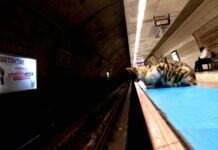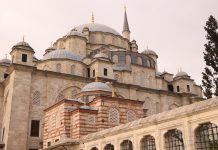For those of you who haven’t been there, Sultangazi sits on the furthermost outskirts of Istanbul, out near the highway that heads up to Edirne. Here, the neighborhoods are poor, beat and conservative – a long, long way from the breezy cosmopolitan shores of Beşiktaş and Moda.
You can even see where the city ends, those flat and green hillsides out beyond the last of the tenement buildings, narrow streets and dust-colored mosques. The whole district feels like many of Istanbul’s outskirts – disjointed, dusty and better seen through the black-and-white lens of a neorealist film director.
Amidst this modern day Valley of Ashes, you have the Venezia Megaoutlet, this massive, Colosseum-looking place, raising its broad, semi-circular facade up and hurling itself onto the city’s skyline.
My first impression of the Venezia Megaoutlet, seeing it on my way out to the university in Sultangazi where I teach, was that it looked a bit like the Colosseum in Rome. Since then, I’ve passed it every day, and always wondered what it was like on the inside.

Entering the complex, after passing through a metal detector of course, the first thing you see is a kind of piazza. And canals. Yes, there are actually canals, with footbridges. And gondolas – well, two of them anyway.
So – that’s where the name “Venezia” comes from: You’re now standing in a kind of mini-Venice. In Sultangazi.
That morning the gondolas were parked at the foot of the canal. The idea of a gondola ride in Sultangazi on a perfectly average Tuesday was worth at least investigating.
A young Turkish guy named Burak was working. Tall, dark and lean, he passed the gondolier eye test. All gondoliers should be tall, dark and lean.
“Gondola ne kadar?” I asked. “30 lira,” he answered matter-of-factly. “30 lira? For how long?”
“Yedi dakika,” he replied. “Seven minutes.”
Non importa. Forget it. I’m not paying 30 lira for a 7-minute gondola ride. My sources tell me a lot of Arabs live in the apartments, or maybe they just rent them during their shopping sojourns to Istanbul. Indeed, the signs were in Arabic as well as English and Turkish. So one supposes the gondola rides are just aesthetic – for parents and their kids to take (expensive) selfies, most likely.
That’s well and good if you are a rich Arab. As for my English-teaching ass, I was like, OK, what else you got, Venice-in-Sultangazi?
I scanned the piazza. Well, there is a replica of St. Mark’s Tower right in the center, jutting jauntily upward. Nearby, other buildings, painted bright yellow and rose, approximate the famous Venetian Gothic architecture we’ve all seen movies.
The shops and most of the restaurants are the standard ones you see in shopping malls the World over: the inevitable Nike, Yves-Roucher, Burger King, etc. But having the canal and the piazza setting helps them.
Wandering, browsing, I still couldn’t get over the surrealness of it. Just outside the complex, across the road, stands a prison – and a very Turkish-looking prison it is, old and run down. Folks tell me that the prison is slated for closure, so that should eliminate what must be a bit of an aesthetic crisis for those living in the apartments above the shopping centers. Then again, there’s gotta be a joke floating around (maybe in one of these canals) about what happens when you put gondolas and Turkish prisons next door to one another: Gondolier walks into a bar, orders an alco-traz. Barman says: “Sorry, we don’t serve that drink. But you might try across the road!”

Just outside the complex, work on a new subway line continues, set to be complete in the next year or so. When it opens, it will run all the way to Beşiktaş. So maybe then it won’t seem so hell and gone.
But that may all be according to plan.
The 82,000-square-meter megacenter was built almost a decade ago by a municipal group called Kiptaş. According to their website, the group’s primary mission is to “offer solutions to the irregular settlement of Istanbul.” In other words, get people out of the overcrowded center and out to the ‘burbs – to places like Ataşehir, Umraniye and Sultangazi.
Presumably, Kiptaş developers anticipated that with time, not only would moneyed residents move into the apartments, but also attract other investment to the neighborhood as well.
So is it working? Well, if you’ve lived in this city long enough, you know the answer to that question varies. These days, with the country in recession, and with soaring inflation, one would suspect not so much. There just aren’t that many moneyed people around, not unless they come from places like Qatar. Don’t ask me about the occupancy rate at the Venezia apartments, but I don’t think it’s a ghost town. Just glancing up at some of the windows, you can see there are people there. It’s not a ghost village.
Come to think of it, the whole idea of Venice-in-Sultangazi may not be so absurd. I think of the Dakota in New York, one of the most famous apartment buildings in the city. Back when it was built in the 1880s, the building was so far away from the city that the developers jokingly dubbed it the Dakota, meaning it might as well have been in North Dakota or thereabouts.
Of course, over the decades, the city grew exponentially, spreading all over Manhattan and beyond, to where today the Dakota sits on what is now known as the Upper West Side. The city grew, taking the Dakota along for the ride.
With that analogy in mind, one thinks: maybe the developers aren’t merely dreaming. Maybe they have the same sense of humor, that Sultangazi is so far away from the center of Istanbul that it might as well be Venice. Bum-fuck Egypt (BFE Megacenter) somehow doesn’t have the same ring, I guess. Still, at the rate this city keeps growing – 15 million and counting – maybe someday Sultangazi won’t be the boondocks anymore. Like the Dakota, maybe the Venezia’s fortunes will rise with the city. One day, Sultangazi could be a desired, sought-after place to live – instead of the dusty boondocks it is at present.
“Well, it is the future of the city,” concurs at least one of my colleagues. “This is where the city is going. The old city, with its narrow streets, its traffic … the city is moving away from that.”

Maybe some day I’ll look back and remember a time when Sultangazi was very different, and I had my own private Venice-in-Sultangazi. All that still seems very remote, especially as I leave the complex and walk back out to the street. The trams rattle past, taking most people into the city proper. I catch a minibüs that moves along very slowly, looking for scant mid-day passengers.
I think of my conversation with Burak, my would-be gondolier.
“It’s very slow,” I said. “Çok sessiz.”
“Yes, very quiet right now,” he said. “But come back on the weekend. It’s very busy. Çok kalabalık!”
Maybe sometime with my wife some weekend. But I know my wife. She’s not gonna pay 30 lira for a 7-minute gondola ride either.
All photos courtesy of the author.
James Tressler is a writer and teacher who has written several books about Istanbul. He lives with his wife Özge in Üsküdar.










